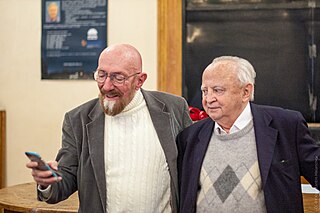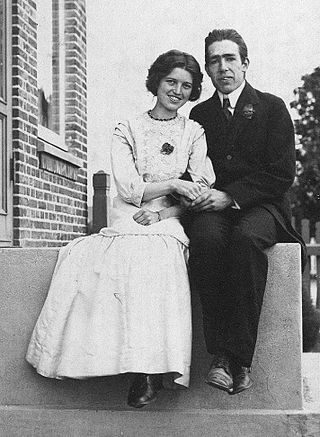
Aage Niels Bohr was a Danish nuclear physicist who shared the Nobel Prize in Physics in 1975 with Ben Roy Mottelson and James Rainwater "for the discovery of the connection between collective motion and particle motion in atomic nuclei and the development of the theory of the structure of the atomic nucleus based on this connection". His father was Niels Bohr.
The Copenhagen interpretation is a collection of views about the meaning of quantum mechanics, stemming from the work of Niels Bohr, Werner Heisenberg, Max Born, and others. The term "Copenhagen interpretation" was apparently coined by Heisenberg during the 1950s to refer to ideas developed in the 1925–1927 period, glossing over his disagreements with Bohr. Consequently, there is no definitive historical statement of what the interpretation entails.

Niels Henrik David Bohr was a Danish physicist who made foundational contributions to understanding atomic structure and quantum theory, for which he received the Nobel Prize in Physics in 1922. Bohr was also a philosopher and a promoter of scientific research.

A galaxy cluster, or a cluster of galaxies, is a structure that consists of anywhere from hundreds to thousands of galaxies that are bound together by gravity, with typical masses ranging from 1014 to 1015 solar masses. They are the second-largest known gravitationally bound structures in the universe after some superclusters (of which only one, the Shapley Supercluster, is known to be bound). They were believed to be the largest known structures in the universe until the 1980s, when superclusters were discovered. One of the key features of clusters is the intracluster medium (ICM). The ICM consists of heated gas between the galaxies and has a peak temperature between 2–15 keV that is dependent on the total mass of the cluster. Galaxy clusters should not be confused with galactic clusters (also known as open clusters), which are star clusters within galaxies, or with globular clusters, which typically orbit galaxies. Small aggregates of galaxies are referred to as galaxy groups rather than clusters of galaxies. The galaxy groups and clusters can themselves cluster together to form superclusters.

Igor Dmitriyevich Novikov is a Russian theoretical astrophysicist and cosmologist.
In philosophy, philosophy of physics deals with conceptual and interpretational issues in modern physics, many of which overlap with research done by certain kinds of theoretical physicists. Philosophy of physics can be broadly divided into three areas:

Sandra Moore Faber is an American astrophysicist known for her research on the evolution of galaxies. She is the University Professor of Astronomy and Astrophysics at the University of California, Santa Cruz, and works at the Lick Observatory. She has made discoveries linking the brightness of galaxies to the speed of stars within them and was the co-discoverer of the Faber–Jackson relation. Faber was also instrumental in designing the Keck telescopes in Hawaii.
The Technical University of Denmark, often simply referred to as DTU, is a polytechnic university and school of engineering. It was founded in 1829 at the initiative of Hans Christian Ørsted as Denmark's first polytechnic, and it is today ranked among Europe's leading engineering institutions. It is located in the town Kongens Lyngby, 12 kilometres (7.5 mi) north of central Copenhagen, Denmark.

Ben Roy Mottelson was an American-Danish nuclear physicist. He won the 1975 Nobel Prize in Physics for his work on the non-spherical geometry of atomic nuclei.
The Center for Planetary Research at the University of Copenhagen was created in February 2001 when the planetary science groups from the Niels Bohr Institute and the Danish Space Research Institute (DSRI) [Danish: Dansk Rumforskningsinstitut, short DRI or DRKI] were merged. It no longer existed in August 2011. Together with associated national and international groups it aimed to strengthen planetary research in Denmark and to provide a platform for the education of planetary researchers. It spanned a broad range of disciplines from astronomy, physics, geophysics, and space instrumentation to geology and biology.

Richard Salisbury Ellis is Professor of Astrophysics at the University College London. He previously served as the Steele Professor of Astronomy at the California Institute of Technology (Caltech). He was awarded the 2011 Gold Medal of the Royal Astronomical Society, in 2022 the Royal Medal of the Royal Society and in 2023 the Gruber Prize in Cosmology.
Bjarne Tromborg is a Danish physicist, best known for his work in particle physics and photonics.
The Bohr family is a Danish family of scientists, scholars and amateur sportsmen. The most famous members are Niels Bohr, physicist and winner of the Nobel Prize in Physics in 1922, Aage Bohr, son of Niels, also a physicist and in 1975 also received the Nobel Prize and Harald Bohr, mathematician and brother of Niels.
The UNESCO Niels Bohr Medal was first minted in 1985 to commemorate the 100th anniversary of the birth of the Danish nuclear physicist Niels Bohr. It is awarded by UNESCO to recognise those who have made outstanding contributions to physics through research that has or could have a significant influence on the world.

Helge Stjernholm Kragh is a Danish historian of science who focuses on the development of 19th century physics, chemistry, and astronomy. His published work includes biographies of Paul Dirac, Julius Thomsen and Ludvig Lorenz, and The Oxford Handbook of the History of Modern Cosmology (2019) which he co-edited with Malcolm Longair.

Chanda Prescod-Weinstein is an American theoretical cosmologist and particle physicist at the University of New Hampshire. She is also an advocate of increasing diversity in science.
N. Asger Mortensen is a Danish theoretical physicist who has made contributions to the fields of nanotechnology, including mesoscopic physics, nanofluidics, photonic-crystal fibers, slow light photonic crystals, and plasmonics. He is known for his contributions to understanding nonlocal light-matter interactions at the interface between classical electromagnetism and quantum physics.

The Institute of Theoretical Astrophysics is a research and teaching institute dedicated to astronomy, astrophysics and solar physics located at Blindern in Oslo, Norway. It is a department of The Faculty of Mathematics and Natural Sciences at the University of Oslo. It was founded in its current form by Svein Rosseland with funding from the Rockefeller Foundation in 1934, and was the first of its kind in the world when it opened. Prior to that, it existed as the University Observatory which was created in 1833. It thus is one of the university's oldest institutions. As of 2019, it houses research groups in cosmology, extragalactic astronomy, and The Rosseland Centre for Solar Physics, a Norwegian Centre of Excellence.

Sune Toft is a professor of Cosmology and Extragalactic Astrophysics at the Niels Bohr Institute. His research focuses on understanding the cosmic origin and evolution of galaxies.

Margrethe Nørlund Bohr was the Danish wife of and collaborator, editor and transcriber for physicist Niels Bohr who received the Nobel Prize. She also influenced her son, Nobel Prize winner Aage Bohr.
















